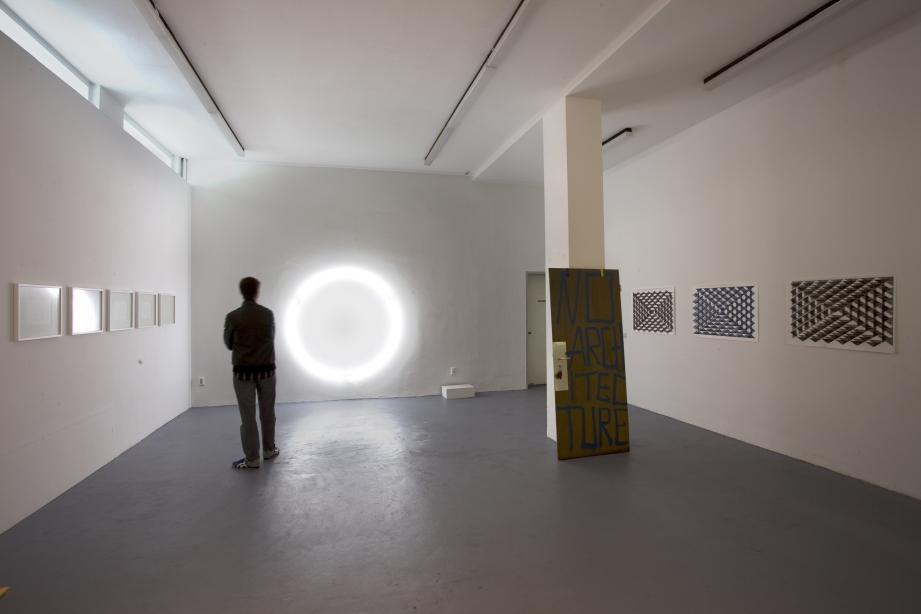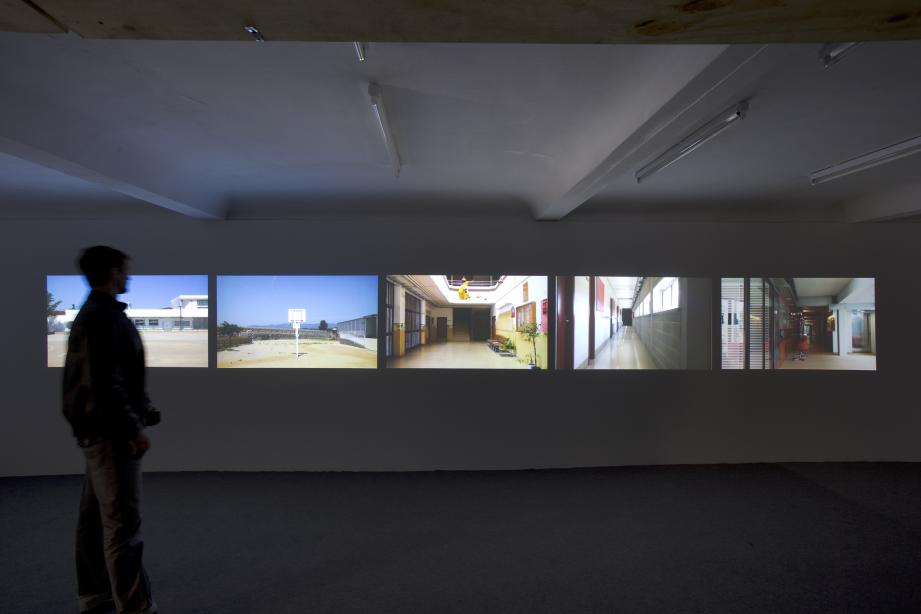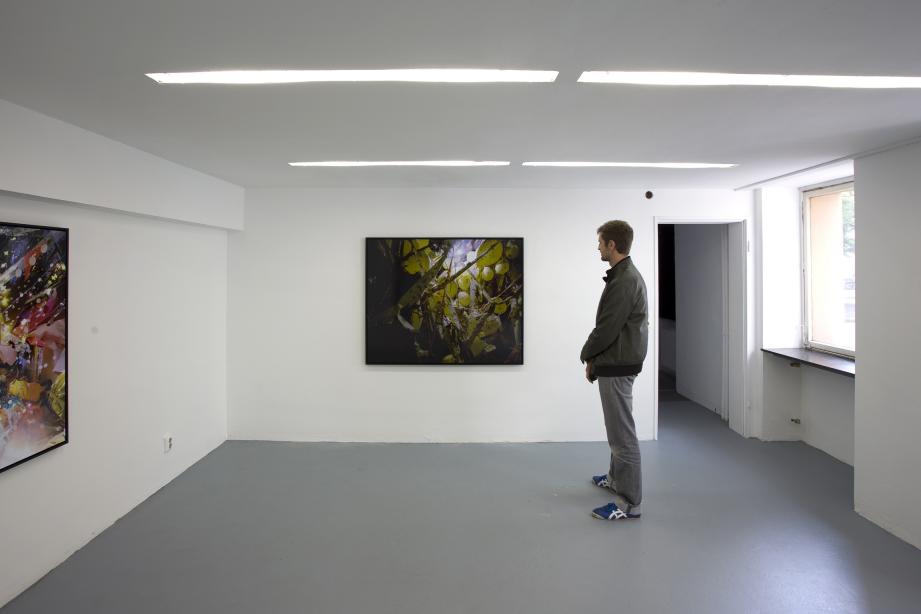You are here
opening
opening hours
tuesday- friday
11:00 - 19:00
saturday, sunday
12:00 - 18:00
location
Isabel Albrecht, Verónica Aguilera, Valentin Beinroth, Johanna Bieligk, Nicolaj Dudek, Wiebke Grösch, Özlem Günyol, Florian Jenett, Stefanie Kettel, Sandra Kranich, Astrid Korntheuer, Levent Kunt, Mustafa Kunt, Frank Metzger, Nashun Nashunbatu, Stefanie Pretnar, Katharina Schücke, Oliver Voss
Curated by Ludwig Seyfarth
Welcoming speech: Prof. Dr. Felix Semmelroth, Head of Department for Cultural Affairs in Frankfurt
Artists move in multiple spaces. They work in studios often until late into the night, they go out and display their work in exhibitions, they deal with the cities in which they live or with completely different places because they travel afar and often.
Those who brood within their own four walls sometimes come up with strange ideas which are better off not being realized. “Poisoning pigeons in the park” was just such an idea, written and composed by Viennese song-maker Georg Kreisler in an ironically sinister style. But even non-contaminated birdseed is not really able to leave the atelier. Wiebke Grösch and Frank Metzger were not permitted to have peddlers distribute pigeon feed to pedestrians on the Konstablerwache. At the Piazza San Marco in Venice, bird-feeding which used to be an almost obligatory part of the tourist routine, has been forbidden since 2007 for hygienic reasons. Is a basic understanding of the city and its public spaces not reflected in the treatment of its feathered residents?
The reality of “outside”, often so recalcitrant and evoked so strongly in the program of this year’s Berlin Biennial contrasts strongly with the imagined space as can be seen in the large paintings of Mongolian-born Nashun Nashunbatu. In the expanse of the landscape whose almost meditative calm is interrupted by blazes or other natural incidents, the painter links his own childhood memories with the Chinese pictorial tradition as well as influences from European landscape painting. The imagined landscape functions like a mirror of the soul but the entity is fictitious. Landscape pictures were collages long before the term existed and this is clearly the case with Stefanie Kettel’s work, in which mountain vistas such as those on picture postcards suddenly appear next to abstract crystalline formations.
Where do the pictures come from? Or perhaps a more appropriate question is: What has become of what was placed in the picture? Nicolaj Dudek prefers the medium of drawing and responds to his visual environment like a seismograph, charting it in a quasi-subjective way, directing attention to surprising details or letting the drawn motifs sometimes disappear again like phantom images.
Özlem Günyol and Mustafa Kunt let objective cartography essentially implode by drawing the silhouettes of all the countries in the world one on top of one another. All 246 existing national flags are superimposed to generate a single image. This appears like phantom image of globalization whose borders (considered insurmountable by many) here, at least, appear to dissolve.
Valentin Beinroth attempts to measure the world in a whole new way. He systematically explores the possibility that scale can be recorded in a completely different way than in the existing standards – which already differ as can be seen in the difference between centimeters and inches. An enlarged NASA reference cube is based on the oldest known unit of measurement in the world, the Nippur cubit. An exhibited object which looks like an Asian folding screen, painted on both sides with an image of a sea freight container plays on new measurements of economic transport routes. The inscription with the name of the Hong Kong and Taiwan-based shipping companies is painted over on the containers, but is now so indistinct as to force us to guess it.
We see nothing but geometric formations. Or do we see something else? Are the triangles in Sandra Kranich’s water colors and their arrangement the result of conscious design or are they taken from an external reality and then placed isolated in the picture? What is not apparent here is the product of systematic research in Katharina Schücke’s work. The artist’s dialogue with the architectural inheritance of former East Germany and especially with the buildings of Josef Kaiser in the vicinity of Berlin’s Karl Marx Allee, can be found, on the one hand, in photographs which are processed to the point of being barely recognizable. On the other, Schücke focuses on the confrontation of the closed architectural line with the need for openness and transparency. For the period of the exhibition her atelier will remain open, as the detached door has become part of her installation.
The circular neon tube by Levent Kunt could in itself be a self-sufficient light object in the tradition of Dan Flavin. Yet here, too, the abstraction is a reduced “translation” of a gymnastics ring with a diameter of 1.8 meters. Kunt watched a street artist in Paris entertaining tourists with the ring, something he had presented in five textbook-like silhouette drawings.
The books which Oliver Voss has on his shelf are, along with the music, one of the most important sources of inspiration for his art. While in a photograph you can still identify the titles, in one of his paintings the book spines appear as black gestural bars. The “erased” information results in an abstract image.
On the CRT monitors which lie on their back on the floor in Florian Jenett’s installation, quite different information orders itself into abstract serial patterns. The work deals with advertising banners which run on over 9,000 international Internet portals. A special software continuously downloads such banners live, so that in spite of the principle of random chance a multifarious image is created of what is being advertised in the world at a certain point in time - also a phantom image of globalization.
Jennett offers us a vivid image of the impossible “back translation” of digital monetary transactions into physical experience – with an FIBC sack such as is normally used for rubble, sand or gravel. It is filled with a ton of Euro cent coins, which in view of their weight has a comparatively low counter value of EUR 4347.83. There used to be a joke about the international revaluation of Polish currency: One pound sterling = one pound of Zloty.
Isabel Albrecht’s pictures also represent a reflection of the digital in an analogue material. The photographic motifs with which she starts, such as the calyx of a flower, dissipate so strongly in a grid of gray tones that an almost monochromatic impression emerges along with a trompe l’oeil: From the distance it looks like a picture board with inserted pins or a sequin picture, but on closer inspection we can see that is has been carefully painted.
Astrid Korntheuer’s photographs can also give the impression of trompe l’oeil images. The complex, colorful arrangements made of paper, strings and diverse materials form an almost impenetrable tangle that does not offer any clear spatial orientation even if you study it for a longer period of time – what you will note, however, is the careful compositional order.
From abundance to emptiness: Verónica Aguilera presents five dismal playgrounds in a video installation. It is hard for the uninitiated to know whether we are in Spain or the Frankfurt region – like in Arte TV channel’s guessing game “Carambolage” in which you have to discover whether a certain image was taken in Germany or France. The loud sirens which summon pupils back to their lessons, however, sound unusual and like fire alarms being tested to local ears. The trick is: there are no children in the schoolyard, the shots are taken in the summer holidays.
By redesigning the bar Stefanie Pretnar and Johanna Bieligk make sure that there are not only breaks in summer and describe their conceptual work as follows: “The space-filling work »BENEFITS IN KIND (FÜR MICH, FÜR MEINE FREUNDE)« slows down the visit to the exhibition, holds the artist working in a studio at basis off from making art. (...) The coffee break is raising the heartbeat. By their continuous engagement the 'bartenders' will create a programm that will last over the course of the exhibition.“
When art succeeds in delivering vivid metaphors, or in other words, revealing new perspectives of the complexity of today’s world, then it is an indispensable staple and also an effective antidote to world views which have lost that sense of potentiality that Robert Musil swears by, has been lost.
Ludwig Seyfarth
Paper Feeder
basis Posterpublikation
In addition to the exhibition curated by Ludwig Seyfarth the artists which work in the studios provided by basis are presenting themselves and their work in form of a poster-like publication.
Each artist creates a poster in the size of DIN A1. All posters are placarded on the wall of the exhibition space. Moreover the individual posters are compiled to a magazin that will be presented in the exhibition and can be taken home by the visitors
***********************
Ludwig Seyfarth lives and works as art critic and curator in Berlin. He organized numerous exhibiton projects, such as „Fliegende Kühe und andere Kometen. Nicht nur komische Dinge in der Kunst“ (in collaboration with Andreas Baur), Villa Merkel, Esslingen, 2006/07; Geheimnis und Öffentlichkeit, Blashofer Contemporary Projects, Berlin, 2006/07; The Fate of Irony, KAI 10, Düsseldorf, 2010 (in collaboration with Zdenek Felix) and Liaisons Dangereuses, Thomas Rehbein Galerie, Köln 2010. Recent publications are Unsichtbare Sammlungen. Kunst nach der Postmoderne, Reihe Fundus, Philo Fine Arts, Hamburg 2008. Ludwig Seyfarth holds lectureships at several German Art Academies.
Kindly supported by











